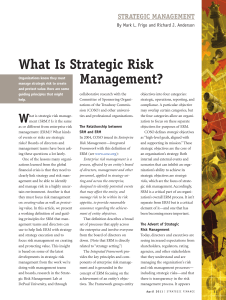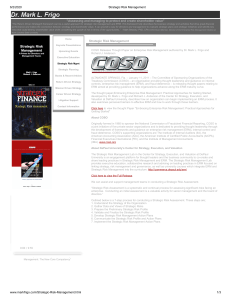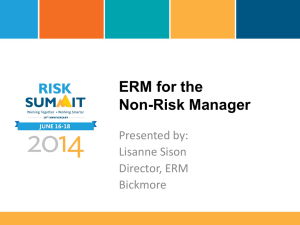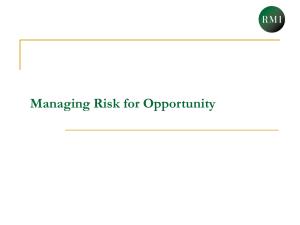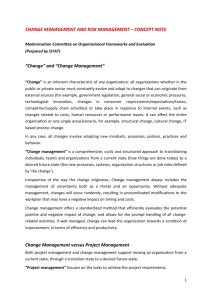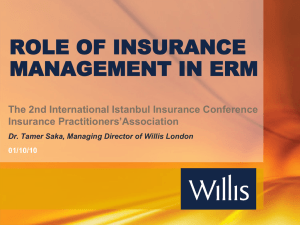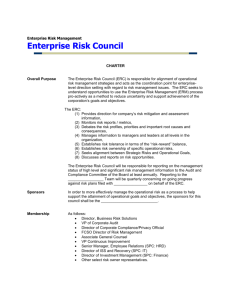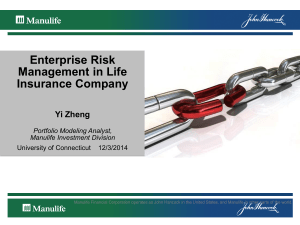Strategic Risk Management: The New Core Competency
advertisement
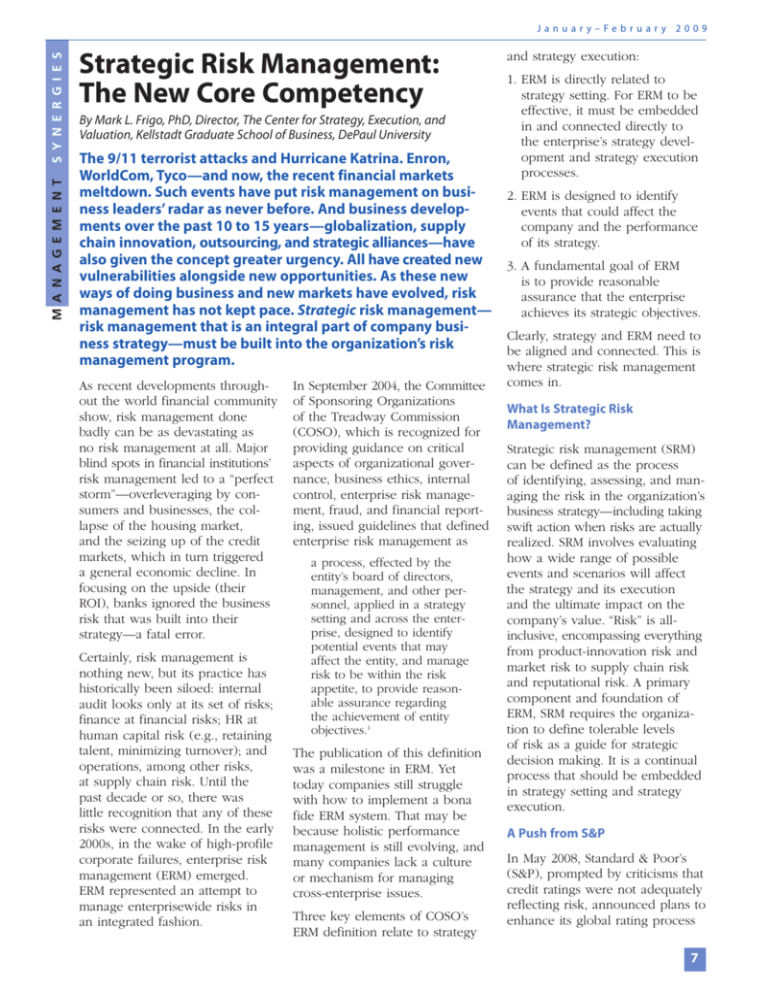
M A N A G E M E N T S Y N E R G I E S January–February 2009 Strategic Risk Management: The New Core Competency By Mark L. Frigo, PhD, Director, The Center for Strategy, Execution, and Valuation, Kellstadt Graduate School of Business, DePaul University The 9/11 terrorist attacks and Hurricane Katrina. Enron, WorldCom, Tyco—and now, the recent financial markets meltdown. Such events have put risk management on business leaders’ radar as never before. And business developments over the past 10 to 15 years—globalization, supply chain innovation, outsourcing, and strategic alliances—have also given the concept greater urgency. All have created new vulnerabilities alongside new opportunities. As these new ways of doing business and new markets have evolved, risk management has not kept pace. Strategic risk management— risk management that is an integral part of company business strategy—must be built into the organization’s risk management program. As recent developments throughout the world financial community show, risk management done badly can be as devastating as no risk management at all. Major blind spots in financial institutions’ risk management led to a “perfect storm”—overleveraging by consumers and businesses, the collapse of the housing market, and the seizing up of the credit markets, which in turn triggered a general economic decline. In focusing on the upside (their ROI), banks ignored the business risk that was built into their strategy—a fatal error. Certainly, risk management is nothing new, but its practice has historically been siloed: internal audit looks only at its set of risks; finance at financial risks; HR at human capital risk (e.g., retaining talent, minimizing turnover); and operations, among other risks, at supply chain risk. Until the past decade or so, there was little recognition that any of these risks were connected. In the early 2000s, in the wake of high-profile corporate failures, enterprise risk management (ERM) emerged. ERM represented an attempt to manage enterprisewide risks in an integrated fashion. In September 2004, the Committee of Sponsoring Organizations of the Treadway Commission (COSO), which is recognized for providing guidance on critical aspects of organizational governance, business ethics, internal control, enterprise risk management, fraud, and financial reporting, issued guidelines that defined enterprise risk management as a process, effected by the entity’s board of directors, management, and other personnel, applied in a strategy setting and across the enterprise, designed to identify potential events that may affect the entity, and manage risk to be within the risk appetite, to provide reasonable assurance regarding the achievement of entity objectives.1 The publication of this definition was a milestone in ERM. Yet today companies still struggle with how to implement a bona fide ERM system. That may be because holistic performance management is still evolving, and many companies lack a culture or mechanism for managing cross-enterprise issues. Three key elements of COSO’s ERM definition relate to strategy and strategy execution: 1. ERM is directly related to strategy setting. For ERM to be effective, it must be embedded in and connected directly to the enterprise’s strategy development and strategy execution processes. 2. ERM is designed to identify events that could affect the company and the performance of its strategy. 3. A fundamental goal of ERM is to provide reasonable assurance that the enterprise achieves its strategic objectives. Clearly, strategy and ERM need to be aligned and connected. This is where strategic risk management comes in. What Is Strategic Risk Management? Strategic risk management (SRM) can be defined as the process of identifying, assessing, and managing the risk in the organization’s business strategy—including taking swift action when risks are actually realized. SRM involves evaluating how a wide range of possible events and scenarios will affect the strategy and its execution and the ultimate impact on the company’s value. “Risk” is allinclusive, encompassing everything from product-innovation risk and market risk to supply chain risk and reputational risk. A primary component and foundation of ERM, SRM requires the organization to define tolerable levels of risk as a guide for strategic decision making. It is a continual process that should be embedded in strategy setting and strategy execution. A Push from S&P In May 2008, Standard & Poor’s (S&P), prompted by criticisms that credit ratings were not adequately reflecting risk, announced plans to enhance its global rating process 7 Balanced Scorecard Report for nonfinancial companies to include a review of their ERM programs.2 By Q4 of 2008, S&P began including commentary on companies’ ERM programs in its ratings reports. The reviews focus predominantly on two aspects of ERM: (1) strategic risk management and (2) risk culture and governance. According to S&P, an organization’s strategic risk management process should include: • Management’s view of the most consequential risks that the firm faces, along with information on how frequently it updates its list of top risks • An understanding of the influence of risk sensitivity on liability and financing decisions • The role of risk management in strategic decision making Besides encouraging companies to incorporate risk management in their strategy decisions, S&P also looks for “internal and external risk-management communications” and “broad riskmanagement policies and metrics for successful risk management” as ways for companies to foster a risk-conscious culture and governance. Are companies rushing to adopt these practices? In recent conference presentations, I asked senior business executives to rate their organizations on the following, on a scale of 1 to 10 (with 10 being “highly integrated” or “highly aligned”): • How well are strategic planning and risk management integrated and coordinated in your organization? • How well are performance measures aligned with risk management in your organization? The vast majority rated their organization a 4 or below. So how can organizations do a better job of aligning strategy and performance measures with risk management? They must begin with a way to identify and assess strategic business risk. A Framework for Strategic Risk Management The Return Driven Strategy framework that Joel Litman and I developed during a decade-long study describes the types of business strategy and activities that have been shown to drive superior and sustainable performance. The framework is based on our extensive study of more than 15,000 high-performance companies around the world, using more than 25 years of performance data.3 The Return Driven Strategy framework is built on a simple premise: by better understanding how the success or failure of a business is driven by its plans and actions, we can improve how we value companies—and run our businesses. The framework is composed of 11 core tenets and three foundations that form a hierarchy of interrelated activities that companies must perform to deliver superior performance. (See Figure 1.) Our research provides valuable insight about risk management. High-performance companies are vigilant about the forces of change, and they manage risks and opportunities better than other companies. The Return Driven Strategy framework provides a way to evaluate the range Figure 1. The Return Driven Strategy Framework Ethically maximize wealth Innovate offerings Partner deliberately Map and redesign processes Target appropriate customer groups Deliver offerings Engage employees and others Brand offerings Balance focus and options Communicate holistically Genuine assets Vigilance to forces of change Disciplined performance measurement and valuation The Return Driven Strategy framework, made up of 11 core tenets (the boxes on the pyramid) and three foundations, provides a way to evaluate the range of strategic risks a company faces. (“Deliver Offerings” is slightly elevated to show it is the most important of the three “competency tenets.”) 8 Version 7.2. Copyright ©2000–2009, Frigo and Litman Fulfill otherwise unmet customer needs January–February 2009 of strategic risks a company faces, including customer and market, operational, innovation, R&D, partnering, supply chain, employee engagement, brand, and reputational risk. It provides a way for understanding the cause-and-effect linkages in critical risk scenarios and reveals how those scenarios would play out in the business strategy and impact revenue, earnings, and shareholder value. As directors and management teams have used the framework to develop and evaluate their business strategy, they have been able to home in on key risks that could destroy shareholder value, while considering upside risk— the opportunities. Companies can use the framework to identify and assess risk in their strategic plans, to develop performance measures to monitor those risks, and to identify risk metrics for Balanced Scorecards and strategy maps.4 Understanding Strategic Risk: A Supply Chain Example Examining strategic risk management in the supply chain offers insights about linking strategic risk management to operations. Every company’s supply chain has certain inherent risks that need to be assessed, measured, monitored, and managed. Managing the supply chain may be an operational activity, but for many companies, like Nokia and Ericsson, the supply chain strategy must be linked to the organization’s overall strategy of the organization. What initially seemed a minor value-chain disruption for Nokia and Ericsson in March 2000 turned out to be a critical event for both companies. On Friday, March 17, a line of thunderstorms hit Albuquerque, New Mexico. A lightning bolt struck a Philips semiconductor plant that manufactured chips for both Nokia and Ericsson, causing a fire. The fire was minor, lasting only 10 minutes. Since the damage at first appeared to be limited, Philips expected to be back in operation within a week. As it turned out, the disruption to the plant lasted months, and the impact on production was significant. Nokia recognized there was a problem with parts supply even before Philips informed it about the magnitude of the problem. Nokia acted quickly once it determined the potential impact of the supply disruption—the inability to produce four million handsets, some 5% of the company’s sales at the time. In contrast, Ericsson responded slowly, and had no alternative sourcing options. By the time its management realized the extent of the problem, the company had nowhere else to turn for several key parts. Said one Ericsson manager, “We did not have a Plan B.” This stemmed partly from the strategy the company adopted in the mid-1990s, when it simplified its supply chain to cut costs and, in the process, weakened its supply backup. Worse still, employees didn’t communicate the importance of the event soon enough. Underestimating the risk of the supply disruption from the Philips plant and the inability to manage the problem were major factors that led to Ericsson exiting the phone headset production market in 2001. What lessons do these contrasting cases offer about managing supply chain risk? • Link the potential impact of supply chain disruptions to revenue and earnings to prioritize and manage risk. • Build in the necessary levels of redundancy and backup and maintain supply chain intelligence and relationships. • Continuously monitor supply chain performance measures to quickly identify problems so that countermeasures can be taken. • Share information and foster communication at the first instance of a problem. Embedding Strategic Risk Management into Performance Management Systems Holistic performance management systems such as the Balanced Scorecard give organizations an unprecedented opportunity to align strategy and performance measures with risk management— and to achieve integrated, strategic risk management. SRM should be a continual process that uses metrics to continuously monitor and manage risk. An organization’s key risk indicators and metrics should link to the potential impact of risk on shareholder value. The BSC framework can help management develop and use these risk metrics. With its focus on strategy and accountability, the BSC can foster a continuous process for risk assessment and risk management. Strategy maps also can provide a useful way to understand the cause-and-effect relationships in critical risk scenarios and can suggest risk metrics that would be valuable in effective risk management. Risk dashboards can also provide a way to monitor key metrics and trends. Kaplan and Norton’s six-stage, closed-loop management system (the Execution Premium model) provides a useful platform for a systematic approach to strategic risk management that integrates with overall management.5 In fact, the Strategic Risk Management Lab in the Center for Strategy, Execution, and Valuation at DePaul University is working with management teams to help them embed strategic risk management into each stage of the management system. For example, in Stage 1, Develop the Strategy, companies would conduct strategic risk assessments and formulate strategic risk management plans 9 Balanced Scorecard Report as part of their strategy. In Stage 2, Translate the Strategy, they would identify strategic risk management objectives and measures that could be included in Balanced Scorecards; they would also use strategy maps to identify the cause-and-effect linkages and root causes of key strategic risks. In Stage 5, Monitor and Learn, management teams would hold strategic risk management reviews. And in Stage 6, Test and Adapt, management would conduct strategic risk analysis. Guidelines for Strategic Risk Management Strategic risk management is increasingly being viewed as a core competency at both the management and board levels. In fact, board members are increasingly focused on SRM, asking executives such questions as “What are the top five strategic business risks the company faces?” “How are you monitoring those risks?” and “What countermeasures are you devising?” The Strategic Risk Management Lab at DePaul is sharing with management teams and boards emerging best practices gleaned from its research. Consider the following a working list of practices worth striving toward. • Communicate and share information across business and risk functions—and externally. This is considered by some to be the ultimate risk management “best practice.” For example, a supply chain group should communicate with the marketing team to coordinate communicating a supply chain disruption to customers. • Break down risk management silos. Establish interdisciplinary risk management teams, so that each functional area can understand where it fits into the entire company strategy and how it affects other areas. 10 • Identify and, where possible, quantify strategic risks. This should be done in terms of their impact on revenue, earnings, reputation, and shareholder value. • Make strategic risk assessments part of the process of developing strategy, strategic plans, and strategic objectives. Again, this requires a combination of skills that can be achieved by creating interdisciplinary teams. • Monitor and manage risk through the organization’s performance measurement and management system. This includes using its Balanced Scorecard to do so. • Account for strategic risk and embed it within the strategic plan and strategic plan management process. Wherever scenario planning is included in the strategic plan, there should also be a discussion of countermeasures in case a risk event occurs. • Use a common language of risk throughout your organization. Everyone must understand the organization’s particular drivers of risk, its risk appetite, and what management considers acceptable risk levels. system should include KRIs, thresholds and trigger points, and countermeasures to mitigate or manage the risk. A Truly Integrated Approach The risks inherent in the siloed approach to risk management have already been demonstrated. Management teams need to embrace strategic risk management as part and parcel of enterprise risk management, creating awareness and building the capabilities to manage those key risks. Strategic frameworks like Return Driven Strategy and systems such as the BSC provide a mechanism for managing strategic risk in an integrated and holistic way, across the enterprise. 1. Enterprise Risk Management—Integrated Framework, Committee of Sponsoring Organizations of the Treadway Commission (COSO), 2004. 2. “Enterprise Risk Management: Standard & Poor’s to Apply Enterprise Risk Analysis to Corporate Ratings,” S&P press release, May 7, 2008. 3. Mark L. Frigo, “Return Driven: Lessons from High Performance Companies,” Strategic Finance ( July 2008). 4. See M. L. Frigo, “When Strategy and Execution Meet,” Strategic Finance ( January 2008); and M. L. Frigo and Richard Anderson, “A Directors’ Primer on Strategic Risk Management,” Strategic Risk Management Working Paper, DePaul University (November 2008). 5. Robert S. Kaplan and David P. Norton, “Mastering the Management System,” Harvard Business Review ( January 2008). T O L E A R N M O R E • Make strategic risk management, like strategy management itself, a continual process. Risk is inherently dynamic, so risk management and assessment must evolve from being an event to being a process—and must include regular analysis, updates, and so forth. Strategic risk management reviews should be conducted as part of regular strategy reviews. For more information about the Return Driven Strategy framework and its applications to strategic risk management, see Driven: Business Strategy, Human Actions, and the Creation of Wealth, by M. L. Frigo and Joel Litman, www.returndriven.com. Also see Mark Beasley and M. L. Frigo, “Strategic Risk Management: Creating and Protecting Value,” Strategic Finance (May 2007). • Develop key risk indicators (KRIs) to continuously monitor the company’s risk profile. Like the BSC with its measures, targets, and initiatives, the risk management As Director of the Center for Strategy, Execution, and Valuation, Mark Frigo also heads the Center’s Strategic Risk Management Lab. He is the Ledger and Quill Alumni Foundation Distinguished Professor of Strategy and Leadership at the Kellstadt Graduate School of Business at DePaul University. Reprint #B0901B


